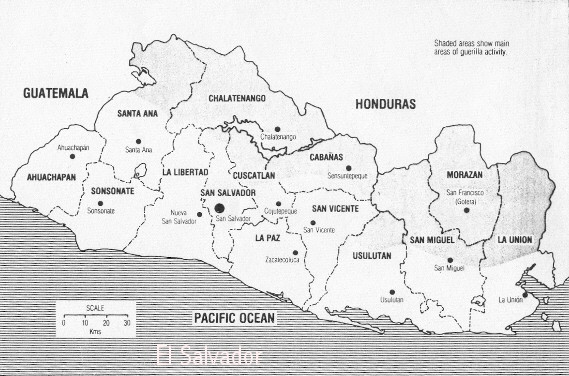Fundamental to understanding El Salvador in the 1980s is the massacre of 1932, La Matanza. The Army killed 8,000-10,000 peasants following an uprising led by Agustín Farabundo Martí. President General Hernández Martínez, the butcher, took control and power thereafter was in the hands of the military.
In the 1960s, economic development and diversification (6% average growth rate in GNP) occurred but wealth becomes more concentrated (10% gets 50%; 1% owned 50% of land: 2% owned 60%). The growth plus better communications created rising expectations in the population. However, the 1969 Soccer War with Honduras caused the virtual end of Central American Common Market, from which El Salvador was benefiting.
From 1961-79, the military ruled through its Party of National Conciliation (PCN) but can't get majority support. Principal opposition parties were the Christian Democratic Party, National Revolutionary Movement, and the Communists (National Democratic Party). Right-wing terrorist and death squads formed: ORDEN, FLANGE, White Warriors' Union, White Hand, anti-Communist Front of Central American Liberation, Secret Anti-Communist Army to combat any political force which was not conservative or reactionary.
Pressure to give more people access to land ownership in order to farm led to the 1970 creation of the First Congress of Agrarian Reform.Talks began but little progress was made since the large landowners and their supporters were not interested in changing anything and believed that they had the force to prevent it.
Cayetano Carpio breaks with Communist party and forms the terrorist Popular Liberation Forces.
In 1972, José Napoleon Duarte (Christian Democrat Party) and Guillermo Ungo (National Revolutionary Movement), candidates for president and vice president, were defrauded of victory by PCN's Colonel Arturo Molina. Attempted coup d'état beaten and Duarte and others were tortured and exiled.
Agrarian reform was being discussed by the military, which meant that it might actually occur.
In 1977, the United Democratic Opposition offers Colonel Claramont as presidential candidate but was defrauded by General Romero. Dissent was repressed. Rise of violent protest occurs.
In August, 1979, the one faction of the military successfully launches a coup against Romero. Junta dismisses 100 officers of armed forces and police who were thought to be connected with extreme right and death squads. Most reinstated after army protests but not army intelligence major Roberto D'Aubuission. In October, there was an attempted right-wing coup. Junta can't control army.
In January, 1980, the Cabinet, most of subcabinet, and some Supreme Court justices resign. During the first 10 weeks of 1980, death squads kill 689. Two days after Attorney General Mario Zamora was denounced by D'Aubuission as a secret Communist Party member, he was killed at a dinner party. On March 5, Duarte was brought into the junta at the insistence of the US government. Banks, export houses were nationalized. the junta begins the expropriation of large private farms. Announced agrarian reform plan: Phase I: parcels of 1235+ acres would be put into cooperatives; Phase II: expropriation of 100-500 hectares (not done); Phase III: tenants can buy up to 7 hectares. Archbishop Oscar Anulfo Romero denounces repression. From the pulpit, he says that soldiers don't have to obey orders against God's law. Killed 2 days later while saying mass in a hospital.
In April, 1980, Republican Nationalist Alliance (ARENA) was formed by D'Aubuisson. In June, the Unified Revolutionary Directorate formed by three guerrilla factions and allies with Democratic Revolutionary Front. In November, six members of the Democratic Revolutionary Front were killed. In December, three US nuns and a US Catholic lay worker were murdered by right wing. On December 13th, Duarte became junta president as the military tries favor with Washington by placing a civilian in the visible leadership position. the power, however, remains with the military.
In 1981, Two US AID land reform specialists and a Salvadoran official killed in Sheraton Hotel coffee shop in January. On January 10th, Farabundo Martí National Liberation Front (FMLN) launches what it calls its "final offensive" but fails. In August, Mexico and France recognize the FMLN as a "representative political force" and call for a negotiated settlement of the civil war. In November, the guerrillas try to bomb their way to victory. In December, U.S. announces it will train Salvadoran troops
In the March, 1982 elections, the PDC got 43% but ARENA and PCN formed the majority in Constituent Assembly. US refuses to accept D'Aubuission as provisional president.
The Contadora Group offers to mediate civil war.
In April, 1982, the Reagan administration's . National Security Council plan, "U.S. Policy in Central America and Cuba Through FY '85," estimates that there are 4-5 thousand guerrillas and sees no victory for them in the near term. The Reagan administration plans to isolate Mexico and social democrats of Europe. Use economic pressure to accomplish goals. Creates the Caribbean Basin Initiative partly to offer a carrot to current and potential anti-conservative forces. Decides to arm and train anti-Sandinista forces for use against Nicaragua.
In the 1979-84 period, the Salvadoran economy declined 25%; unemployment rose to 40%. The country becomes even more dependent on US aid which was $260 million in fiscal year 1984 and $376 million in fiscal year 1985.
In the March, 1984 presidential elections, Duarte received 43% of the vote, D'Aubuission 29%, and Guerrero 19%. In the May runoff elections, Duarte got 55% of the vote. US policy had succeeded in getting a liberal elected to the presidency.
The civil war continued through the 1980s, however, until both sides agreed to quit.
 12101
12101